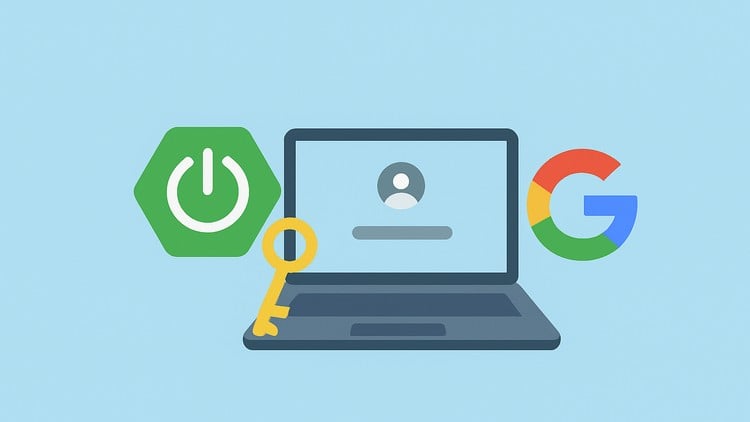
A step-by-step guide to integrating Google’s secure OAuth2 login into your Spring Boot applications
⏱️ Length: 59 total minutes
⭐ 5.00/5 rating
👥 18 students
🔄 August 2025 update
Add-On Information:
Note➛ Make sure your 𝐔𝐝𝐞𝐦𝐲 cart has only this course you're going to enroll it now, Remove all other courses from the 𝐔𝐝𝐞𝐦𝐲 cart before Enrolling!
-
Course Overview
- This course provides a practical deep-dive into modern web application security, focusing on integrating Google’s robust OAuth2 framework for external identity providers.
- Explore architectural patterns for secure microservices, understanding token-based authentication flows and the critical role of identity providers.
- Uncover the value of delegated authorization via OAuth2, moving beyond traditional methods to enhance user experience and adoption.
- Gain insights into managing application state and user context across full-stack applications, bridging backend security with frontend interactivity.
-
Requirements / Prerequisites
- Fundamental Java Programming Proficiency: Solid grasp of Java syntax, OOP, and core libraries (Java 8+ preferred).
- Basic Spring Framework Knowledge: Familiarity with Spring’s IoC, DI, and core modules like Spring Core and Spring Web.
- Web Development Fundamentals: Working knowledge of HTTP, RESTful APIs, and basic web security principles.
- Database Concepts: Understanding of relational databases, SQL, and basic data persistence is beneficial.
- Development Environment Setup: Access to a modern IDE, JDK 11+, Maven/Gradle, and a web browser is required.
-
Skills Covered / Tools Used
- Token-Based Authentication Principles: Master stateless authentication using JSON Web Tokens (JWTs) for API security, covering generation, validation, and secure transmission.
- Advanced Spring Security Configuration: Implement fine-grained access control, custom security filters, and best practices to harden Spring Boot applications.
- Frontend-Backend Communication Security: Configure secure Cross-Origin Resource Sharing (CORS) policies and manage sensitive client-side API credentials effectively.
- Google Cloud Platform (GCP) Essentials: Navigate the Google Developers Console to set up OAuth2 client IDs, authorized redirect URIs, and manage API credentials.
- RESTful API Design & Implementation: Enhance skills in designing and consuming secure RESTful APIs, focusing on authentication, error handling, and data integrity.
- Modern Frontend Framework Integration: Gain practical experience connecting a contemporary JavaScript framework with a Spring Boot backend, specifically for authentication redirects and token management.
-
Benefits / Outcomes
- Develop Robust, Secure Applications: Acquire the expertise to build applications prioritizing security, leveraging industry-standard OAuth2 protocols for reliable user authentication.
- Boost User Experience and Trust: Implement familiar “Login with Google” functionality to streamline onboarding, enhancing user trust and perceived professionalism.
- Expand Your Full-Stack Development Portfolio: Add a critical skill in modern full-stack security integration, showcasing complex authentication handling to employers.
- Become Proficient in Cloud-Native Authentication: Understand how to effectively utilize external identity services, vital for developing scalable, distributed, and cloud-native applications.
- Career Advancement Opportunities: Position yourself as a highly valuable asset by mastering a sought-after skill in secure web development, applicable across diverse projects.
- Foundation for Broader OAuth2 Implementations: The concepts and patterns learned provide a strong base for integrating other OAuth2 providers into your future applications.
-
PROS
- Highly Practical and Project-Oriented: Guides you through building a functional application from scratch, ensuring hands-on skill acquisition and immediate applicability.
- Current and Relevant Technologies: Focuses on cutting-edge, widely adopted technologies like Spring Boot, Spring Security, React, and Google OAuth2.
- Clear, Step-by-Step Instruction: Breaks down complex topics into logical, manageable steps, accessible even for those new to OAuth2 or full-stack integration.
- Enhances Application Security Posture: Teaches secure authentication, crucial for protecting user data and application integrity in web development.
- Increases Developer Efficiency: Learn to quickly integrate established identity providers, saving significant development time over custom authentication systems.
- Excellent for Portfolio Building: Provides a tangible, complete project to demonstrate proficiency in secure full-stack development and external API integration.
-
CONS
- Limited Scope to Google OAuth2: The course’s narrow focus might not delve into the specific nuances of integrating other OAuth2 providers or more advanced OpenID Connect features.
Learning Tracks: English,Development,Software Engineering
Found It Free? Share It Fast!